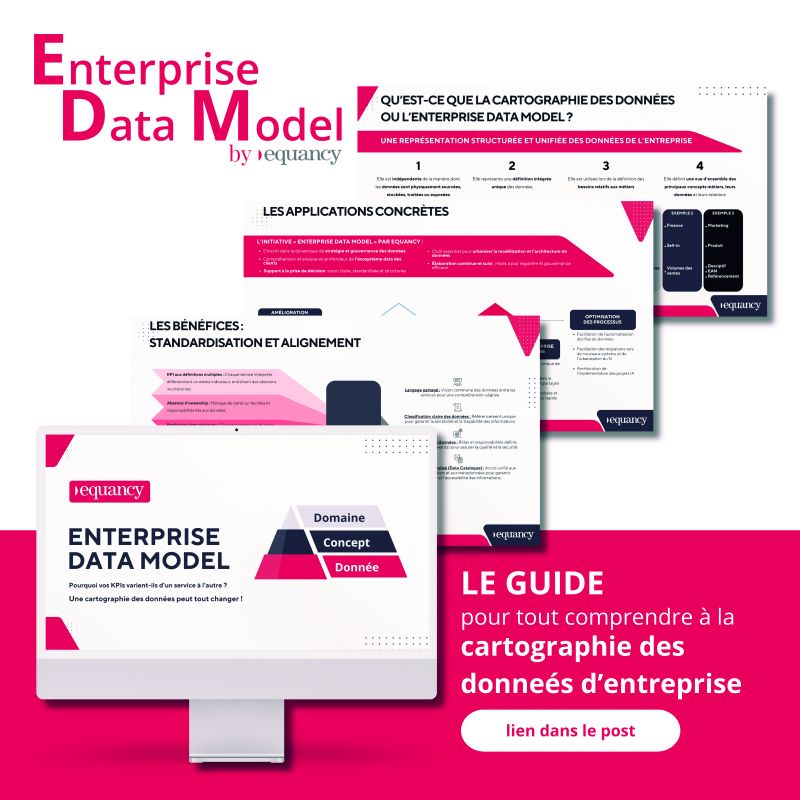The aim of a 'data driven' or 'data centric' company is to integrate data at every level, to make every decision based on reliable and accurate indicators, and to instil a culture of systematic use of data from the start of the day, rather than treating it as an afterthought.
Today, few companies can claim to be 100% Data Driven... Indeed, who can guarantee that ALL, or at least the vast majority, of their company's employees base their work and their decisions on data?
In a world that is becoming increasingly digitised and producing more and more data, if the use of data is the key to business transformation, why isn't it more widespread than that?
A data transformation project is not just a technology project, it's also a cultural and mindset transformation project. You can't have one without the other, and many data transformation projects have failed because the change management, training and communication aspects were largely underestimated.
Even if the use cases in Data Science and AI are a driving force for instilling a transformation dynamic, BI and in particular Self BI (autonomy for business units to build their own dashboards on centrally-governed datasets) are the key to successful business transformation. It is the primary lever for data appropriation.
The success of a data-driven business transformation project hinges on 4 key prerequisites: successfully convincing the target audience (in this case, the business lines), adopting an agile process, supporting change, and recruiting differently.
I. Concrete examples: the best way to convince teams
The first stage in the success of a data transformation project is to convince the teams of the benefits they will derive from changing their working habits by implementing Self BI.
To do this, first and foremost you need to involve the end-users and present them with concrete examples of processes and results to illustrate the changes to their daily habits: "new generation" BI applications.
1. Demonstrate the time savings
All too often, analysing a company's data involves a large number of manual processes on the part of teams: extracting data in CSV format, using Excel formulas to calculate KPIs, presenting analyses in PowerPoint, etc. These processes, which are generally very time-consuming, sometimes take longer than the time allocated to analysis. As a result, teams often ask themselves this question: how can we save time by automating/industrialising the analysis environment?
By using the new dataviz solutions, such as Tableau or Power BI, the benefits are manifold:
- KPI calculations are automated, so there's no need to rerun formulas
- By applying filters and scenarios to your data, you can obtain results quickly, as opposed to building or upgrading an existing report.
- Data is updated automatically at a frequency defined by the user, in real time: no repetitive, low-value-added task of updating reports.
Every member of the team can access these standardised and automated dashboards on different media (laptop, tablet, smartphone, etc.). The time saved on producing reports can then be devoted to analysis and recommendations, which have far greater added value and business impact. By adopting a data culture through the use of BI solutions, companies are "three times more likely to improve their decision-making processes" (PWC study). This is one of the strongest arguments in favour of the benefits of a data-driven enterprise.
2. Offer a new user experience thanks to data story-telling and UX design
For many professions, the use of data is a very abstract concept, even though it is often similar to what they do on a day-to-day basis (i.e. analysing sales, studying customer behaviour). So it's important to flesh out the concept with coherent visuals that are easy to use and attractively designed.
One of the most convincing ways to do this is to emphasise storytelling, which has become much simpler thanks to dashboards and BI self-service in general. Page navigation, dynamic filters and tooltips allow the user to move from one visual to another, resulting in a more fluid and coherent storytelling than on a 'frozen' dashboard, where the visuals do not interact with each other.
It is also necessary to have a design that corresponds to the company's graphic charter. This can take the form of a colour palette specific to the company, its iconography, its logos or even a particular typeface. This charter encourages appropriation by users, by reproducing a familiar environment similar to what they already know.
By creating an attractive user experience that brings together all the features of a dashboard (filters, pages, tooltips, etc.) and reflects the company's image, it will be easier for business users to see themselves reflected.
These new dashboards are also a major lever for accelerating the company's data transformation. Frequently, proudly showing off the new application to colleagues creates such a wow! effect that it encourages other business areas to adopt this new way of building their decision-making tools. This is a major key to success.
3. Ensure data reliability and standardisation thanks to a centralised platform
The reliability and quality of the data is also a good argument for convincing teams to adopt this transformation towards a BI self-service solution.
In many companies, there are multiple sources of data: CRM, ERP, Excel files, etc. This abundance of data sources can lead to a lack of alignment when it comes to KPIs, and can raise questions about the reliability of the data: why do two different teams have different values for the same KPI?
Centralising and using data involves numerous improvements in the day-to-day processes of teams, and is often the reason for creating a data governance body in its own right. By bringing all the data together in a single solution, every member of staff can rely on the same figures as their colleagues. It is possible to create a single source of 'truth' for every player in the company thanks to 3 complementary solutions:
The construction of a centralised data platform, or datalake, with a data architecture organised by specific business area, in which each business area controls and governs its business indicators, is often a prerequisite. This method of organising data, advocated by so-called "data mesh" approaches, is becoming increasingly common in the world of analytics. For example, financial data is stored in a dedicated area, while social data is stored in another area. This gives companies greater autonomy to create their own dashboards by requesting the appropriate data, and the KPIs are standardised. It's also a way of avoiding the bottleneck of concentrating development workloads on central teams.
The use of data catalogue solutions (Data Galaxy, Collibra, etc.) is also a real accelerator in the democratisation of data. These solutions provide access to the functional and technical definitions of the KPIs made available on the platform and in the BI applications.
Finally, you need to be able to ensure the quality of this data across the whole of the company's data environment, with solutions that are sometimes very simple to put in place. For example, a retail company can control the quality of its data by indicating a value range for which a product is sold in its catalogue. If the price displayed for the product is below or above this range, an alert can be sent to the team concerned so that they can analyse the problem and correct it. Specialised data quality solutions such as Unifai and Great Expectation, or more generic/multi-purpose solutions such as Power Apps and Power Automate, can be used to create data quality tools that are accessible to all teams.
By implementing these best practices, teams can ensure that they are in line with the figures before being able to communicate/share them. They also avoid wasting time investigating the asymmetry of a KPI calculation between two teams.
II. Adopt an agile process for building your data applications
A transformation project must be agile in order to:
- Convincing from the outset
- Meet the changing needs of the business
- Involve the vast majority of users
- Make it easy to adopt and use
When launching this type of project, teams are difficult to convince because they often tend to be reluctant to change, particularly because it is time-consuming at the outset. To reassure teams and encourage the implementation of new data tools, it is vital to convince teams from the outset.
1. Involve the business units in workshops where the expression of needs and demonstrations are king
One solution is to organise workshops with all the people involved in the transformation project. The aim of these workshops is to gather together the needs of the business, but also to demonstrate what has been produced so far. These demos can be based on inspiring dashboards that correspond to the different business issues encountered on a daily basis. By viewing these demos based on concrete scenarios, users can imagine other problems or use cases that could be applied to this new solution. By doing this, the business teams will be much more involved in the rest of the project. Certain scenarios not identified during the scoping phase can then emerge, enabling all the needs to be met as the workshops progress.
2. Make the new tools available quickly using sandbox environments
To be able to convince right from the start, it is possible to set up "sandbox" environments, where users can practise with the new tools without affecting the company's data environment. In particular, we can create a fictitious database where business users can query and create their first dashboards without fear of "breaking" the company's data environment.
This sandbox environment can offer different levels of access depending on the data skills of the business: the more skilled the user is in data, the more complex the functionalities of this environment will be.
In contexts where the source data is poorly mastered, or where the user does not clearly know what he wants, development on these sandbox environments becomes a good way of exploring the data, testing different UX with real data, in order to create a mock-up that will be used to express the requirements much more clearly to the target.
III. Supporting change over time
1. The Data Champions, a key contact to be identified quickly
The support process starts as soon as the new dashboards are built, with the identification of Data Champions for each business line, with a view to encouraging and accelerating the acceptance of the new data environment by the teams. Data Champions must be able to help other team members with this project, and must therefore meet certain criteria in order to have the right profile:
- Have a thorough knowledge of the business and its strategic challenges
- Have a particular appetite for data, and possibly experience in this field
- Be open to change
- Be the main point of contact for their team on data issues.
Thanks to these qualities, this profile will have the relevant analytical skills to extract 'business' value from the data. It will just be necessary to support them in the technical skills associated with the tool used and the data environment.
The teams will have greater confidence in the project and the changes being made, because they will be directly represented by one of their members. This encourages exchanges and communication, without involving more people than necessary.
2. Train teams gradually, with several levels of training
A transformation project can be made up of many stages, and it takes time to put in place. If you want this type of project to succeed, you need to support your teams from the start of the project right through to when all the new solutions go live. In the long term, the aim is to have autonomous teams, capable of handling all the data environment solutions put in place during the project. So you need to be careful to start the training at the right time: not too early, because the teams might forget what they've learnt before going live; and not too late, because they need time to adapt to the new working environment.
Each profile has a different vision of data within a team, and some will want to develop their expertise more than others. One solution is to offer several levels of training in the data environment. The first sessions can cover the 'basic' use of the tools: consulting a dashboard, accessing data; while sessions aimed at advanced users can present more complex concepts: creating a dashboard, setting up an alert system, etc.
In some companies, it is common to find data communities where users of the BI solution, for example, come together, as well as internal certifications, attesting to the data skills of the employee. By validating these skills programmes, it is easier to determine each team's appetite for, and even expertise in, data. They are also major communication tools for embodying the company's transformation.
3. Documenting and communicating projects and initiatives
In addition to the training sessions, a great deal of documentation is also needed. The formats can vary: text, video presentation, power point, etc.
Documentation is a step that should not be neglected, as it is essential to the long-term viability of the project. If the company wants to ensure a long-term data transformation, it needs to be able to keep a record of all the information relating to the new tools.
Finally, to ensure that the support provided to the teams lasts, a comprehensive communication system must be put in place to centralise access to these tools, documents and training materials, so that this knowledge and these data assets can be shared easily by all.
The first data portals are flourishing in major groups, either through the development of dedicated websites or intranets, or through the use of tools such as OpenDataSoft or the solution developed by Pernod Ricard, which has more than 9,000 users and is now being offered to the market to pool costs.
IV. Revising the way we recruit
Finally, a successful transformation project implies that the solutions provided will be used optimally by the teams over the long term. Training will enable the company's current talent to be upgraded to different levels of expertise.
At the same time, companies need to review the way they recruit, and include data skills in the selection criteria for most professions. Many training courses now include a data component, using the tools available on the market, and we need to prioritise them: this is no longer just for experts and engineers, it's just as valid for business schools, managers and HR profiles.... And to complete the recruitment process, the in-house training programme should include a data component on the company's own environment for the jobs that require it most.
In conclusion, if a data-driven business transformation project is to succeed, it is essential to mobilise efforts not only on the technical side of the project, but also on the change side, in order to convince teams by showing them the concrete benefits of this change. Involving end users, guaranteeing data quality, identifying data champions, providing ongoing support and reviewing the recruitment process are all crucial steps. By adopting these measures, the company can maximise the impact of its data transformation over time and minimise the risk of failure.
Didier Richaudeau
Data associate




